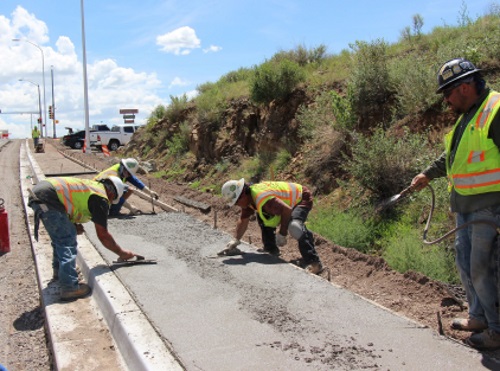FEDERAL ACTION
Pelosi sets Oct 1 target for infrastructure, Biden spending bill – Reuters
Biden’s pro-car, pro-gasoline moves leave green allies fuming – Politico
Bills Gates Promises $1.5 Billion for Green Infrastructure if Congress Passes Plan – ForConstructionPros.com
Federal program to cut bus emissions gets a Senate mandate: Some buses must pollute – Washington Post
COVID-19
As people took up cycling during pandemic, Seattle went on a bike-lane-building binge – Seattle Times
INFRASTRUCTURE RESILIENCE AND SUSTAINABILITY
DOT Secretary: Infrastructure Bill Would Give Big Boost To State’s Electric Vehicle Infrastructure – Wisconsin Public Radio
The Long, Slow Drowning of the New Jersey Shore – New York Times
5 Ways the Infrastructure Bill Would Improve America’s Flood Resilience – Pew
ExxonMobil’s Oil Trucking Plan Hits Environmental Roadblock in Santa Barbara – Santa Barbara Independent
Can The Private Sector Bring About The ‘Greening’ Of Infrastructure? – Forbes (Commentary)
BART releases Sustainability Report showing progress toward goals despite COVID-19 pandemic – Bay Area Rapid Transit District (Media release)
AIR QUALITY
SC Ports given federal grant for emission-reducing trucks – WCIV-TV
How to Win the War on Car Idling – CityLab
Tennessee is ending vehicle emissions testing in these 5 counties – WTVF-TV
First US Hydrogen Fuel Cell Powered Passenger Ferry Launched – Maritime Executive
Colorado Developing New Pollution Reduction Planning Standards to Address Climate Change and Air Quality – Colorado DOT (Media release)
ENVIRONMENTAL JUSTICE
The Role of Microtransit for Better Equity and Inclusion – Mass Transit
NATURAL RESOURCES
Fracking linked to surface water quality for first time in new study – The Hill
A Playbook for Wildfire Mitigation – Utility Products
What does it mean when a community runs out of water? Many in California are finding out – SF Gate
“Pokey picker upper” makes cleaning up highway shoulders easier, reduces waste – Arizona DOT (Media release)
CULTURAL RESOURCES
EPA agreement with Kennedy Center protects water quality of Potomac River, Chesapeake Bay – National Law Review
Two Struggling Icons – Route 66 and Monarch Butterflies – Make for Strange Bedfellows – WTTW-TV
HEALTH AND HUMAN ENVIRONMENT/ACTIVE TRANSPORTATION
Sarasota Police launch education patrols aimed at pedestrian, bicycle safety – WWSB-TV
Savannah Center for Blind and Low Vision unveils training sidewalk – WSAV-TV
TRB RESOURCES/ANNOUNCEMENTS
AASHTO Hosting Environmental Webinar Series – AASHTO Journal
Resilience Primer for Transportation Executives – TRB
From Shellfish to Sunny Day Flooding – Why a GRP Fellow Is Dissecting Water Quality in North Carolina – National Academies of Science, Engineering, and Medicine
FEDERAL REGISTER NOTICES
Approval and Promulgation of Air Quality Implementation Plans; Washington; Low Emission Vehicle Program – EPA (Proposed rule)
Notice of Proposed Supplementary Rules for the Klondike Bluffs Area of Public Lands Managed by the Moab Field Office in Grand County, UT – Bureau of Land Management (Notice)
Temporary Restrictions of Specific Uses on Public Lands Within the Black Rock Desert – High Rock Canyon Emigrant Trails National Conservation Area (Black Rock Desert Playa) Humboldt County, Pershing County, and Washoe County, NV – Bureau of Land Management, (Notice)
Notice of Intent To Prepare an Environmental Impact Statement for the Proposed Lava Ridge Wind Project in Jerome, Lincoln, and Minidoka Counties, Idaho – Bureau of Land Management (Notice)
Notice of Intent To Conduct a Review of the Federal Coal Leasing Program and To Seek Public Comment – Bureau of Land Management (Notice)
Surface Transportation Project Delivery Program; California High- Speed Rail Authority Audit Report – FRA (Notice)
Reopening of Solicitation of Nominations for the Marine Debris Foundation Board of Directors – NOAA (Notice)
Civil Penalties – NHSTA (Supplemental notice of proposed rulemaking)
Notice of Availability of a Final Environmental Impact Statement for South Fork Wind, LLC’s Proposed Wind Energy Facility Offshore Rhode Island – Bureau of Ocean Energy Management (Notice)
Quarterly Status Report of Water Service, Repayment, and Other Water – Related Contract Actions – Bureau of Reclamation (Notice of contract actions)


